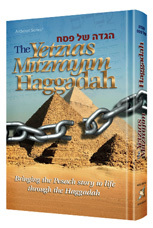The Kosher Bookworm: Final Pesach Hagadah roundup
The Kosher Bookworm
Issue of March 26, 2010/ 11 Nissan 5770 A salesperson in a Hebrew bookstore once told me, “I’m tired of seeing so many new Hagadah commentaries published every year. Do not we have enough of the old Hagadahs to learn from?” “There is not a new Hagadah commentary that does not contain new explanations and new insights,” I answered. Indeed, we are told that one who equips himself with the many commentaries that are available, both new and old, is praiseworthy.This observation is more than just an accurate assessment of what we confront as we visit local book stores. To Rabbi Yitzchok Sender of Chicago, it is a way of life. You see, Rabbi Sender holds the world’s record of having authored four distinct English commentaries on the Hagadah. This is more than what anybody else has achieved to date. Twenty years ago Rabbi Sender authored the first of his comprehensive Commentators’ series of Hagadahs, each to be published by Feldheim Publishers. Each of the succeeding three commentaries was to further add to the plethora of inspiration, midrash, historical data and humor that have helped thousands to better conduct the inspiring seders their families and friends would come to appreciate.
It takes quite a bit of intellectual fortitude to not only compose four Hagadahs but to supplement them with a separate comprehensive commentary on Hallel, a work previously reviewed in this column.
Next time you visit your favorite book store check out Rabbi Sender’s works and sample at least one of the most recent Hagadahs. I an certain that you will want to come back in future years to obtain the previous Hagadahs for your holiday’s reading and learning pleasure.
To no one’s amazement, Artscroll has done it again, giving us a new English translation of Rabbi Yehudah Heimowitz’s, “Haggadah V’Aggadata.” The English rendition, compiled by Rabbi David Grunbaum is titled, “The Yezias Mitzrayim Haggadah.” Its name tells it all.
On every single page this work focuses exclusively upon the exodus experience. The author makes the following observation that I am sure will resonate with readers. Many people get bogged down in the introductory sections with all the preliminary ritual unique to the seder night. This serves to “eat up” a good deal of time, thus diminishing the time left to discuss the exodus in a meaningful manner, before chatzos. The organization of this Hagadah helps to ameliorate this annual dilemma by effectively mainstreaming the midrashim and commentaries dealing with the exodus at every single point in the Hagadah ritual.
Consider the following: The bibliography to this volume lists over 150 classic works that are referenced in the text. However, please do not be overwhelmed by this fact, this Hagadah is very user friendly. The text parses this vast amount of aggadita in a manner that leaves the reader quite effectively informed as to the importance of the role that the exodus has come to serve our people; not just at Pesach time, but year round. This Hagadah is an effective learning tool both for home and school use. Taken together with Rabbi Sender’s “Commentators” series, it would make for excellent Shabbos Hagadol reading this weekend, as well as for the time leading up to the seder itself.
For those of us who enjoy a different take, Devora Publishing has put out a new Hagadah titled, “In Every Generation: The JDC Haggadah,” that features newly released photographs, letter, and documents from the archives of the American Jewish Joint Distribution Committee. This photo essay collection spans the Ethiopian rescue, the Soviet Jewry era, and post-Holocaust Europe, all brought together for the first time in one book thus giving new and very relevant meaning to “V’chol dor v’dor.”
It features a running commentary by Prof. Ari L. Goldman of Columbia University, my former classmate at Yeshiva Rabbi Jacob Joseph (RJJ). Ari’s elegant and eloquent writing style helps to bring each picture to life and gives it all greater historical relevance to the exodus saga.
I am certain that every history buff in your family will find this work to be of great interest.
The last Hagadah commentary that I wish to bring to your attention is authored by Rabbi Yonason Sacks of Yeshiva University, the great grandson of the late chief rabbi of Jerusalem, the great gaon, Rav Pesach Frank, zt”l. This commentary is titled, “Chazon L’Yomim.” It includes a continuous running narrative that blends halachah, medrash, and history in a manner that, when read carefully, will give you the impression of being in a beis medrash listening to a shiur being given by a master rav and maggid shiur.
This is a work of deep learning that deserves your attention. To the best of my knowledge, this is the only English work by Rabbi Sacks and, I trust, not the last.
This concludes this year’s Pesach Hagadah roundup. I hope that these essays helpß you to better evaluate and choose the appropriate Haggadahs for your learning and reading pleasure both for now and in the many years to come. May I take this opportunity to extend to your, my dear readers, a chag kasher v’sha’each.

 74.0°,
A Few Clouds
74.0°,
A Few Clouds 




